These cute rodents get along well with people. However, some of their habits make you wonder how to catch a chipmunk. These animals are close relatives of squirrels but prefer to live in burrows instead of trees. Underground activity can weaken your home’s foundation structures. These cuties are frequent visitors for farm owners and those who live near forests.
Humane methods of catching chipmunks, subject to all the rules, give an excellent result. To find out how to capture a rodent correctly and secure your household, read my article.
[wpsm_titlebox title=”How to Capture a Chipmunk?” style=”main”]
- Buy the one- or two-door cage.
- Note the places of rodent’s activity.
- Put bait (unpeeled peanuts, seeds) into a trap.
- Set the traps in the places where you noticed chipmunks.
- Check the cage twice a day.
- After catching the animal, contact local authorities to release it. [/wpsm_titlebox]
Why Is It Necessary to Capture Chipmunks?
Chipmunks dig underground tunnels that can be up to 30 feet long. However, significant damage to the supporting structures of a house has not yet been recorded. There is such a possibility, but it is unlikely. Leaving chipmunks in your yard for a long time can weaken some elements a bit. However, this is not such huge damage as, for example, caused by termites.
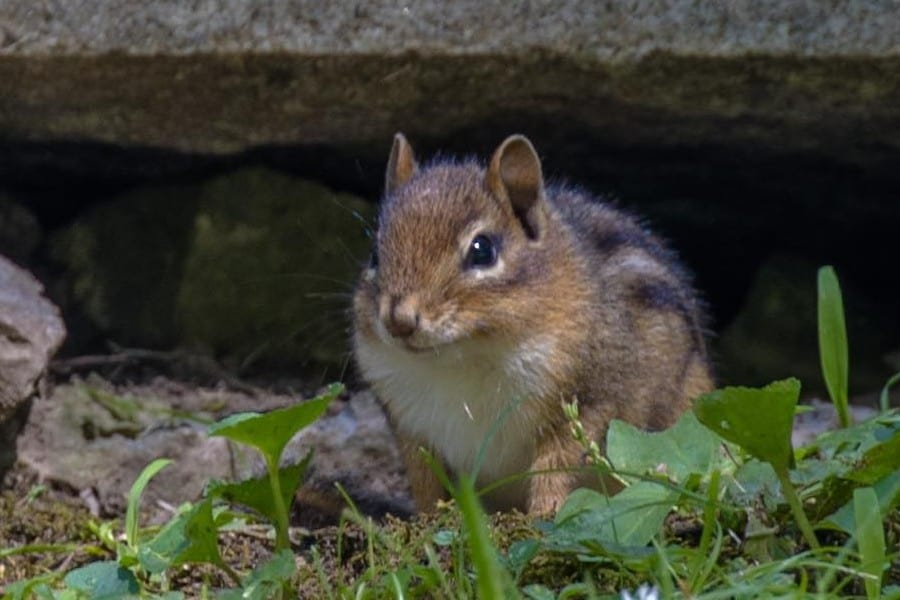
Gardeners and farmers suffer from small rodents the most. They love to eat plant bulbs. The extent of damage in the garden depends on how “tasty” your plant varieties are to the rodent. They also love to eat chicken eggs.
Chipmunks are considered potential carriers of various dangerous infections. In the list of diseases, you can see Colorado tick fever, plague, rabies, and Rocky Mountain spotted fever. Frightening names, but the US has seen a low number of cases in recent years. It is difficult to catch an infection from this rodent. You surely don’t want to be on the list of sick people.
Moreover, droppings, contact with your food, and dirt from the paws have nothing to do with the observance of hygiene rules.
How to Catch Chipmunk: Step-By-Step Guide
It is believed that these animals are difficult to capture. Indeed, they have an excellent sense of smell, hide well, and avoid human contact. Proper observance of the rules for choosing a trap, bait, and their placement will make the process of catching rodents easy.
1. Selecting a chipmunk trap
You can catch a chipmunk without killing it. The most common option is to use a cage with bait. Such traps have one or two entrances. When your guest notices a treat, it enters the cage to feast, and the door slams shut.
Single-door cage:
- Easy to use;
- Efficient bait placement.
Double-door cage:
- A rodent can see through both sides of the cage through the open doors and is unaware that this is a trap;
- Higher chance to catch a chipmunk;
- You can lift one door or both at once.
For a one-door model, place the bait at the end of the cage, and for a two-door one, in the center. These options allow you to take the rodent away from your home after catching it and set it free into the natural habitat. Please note that the size of the cage should be small (about 10-20 inches long).
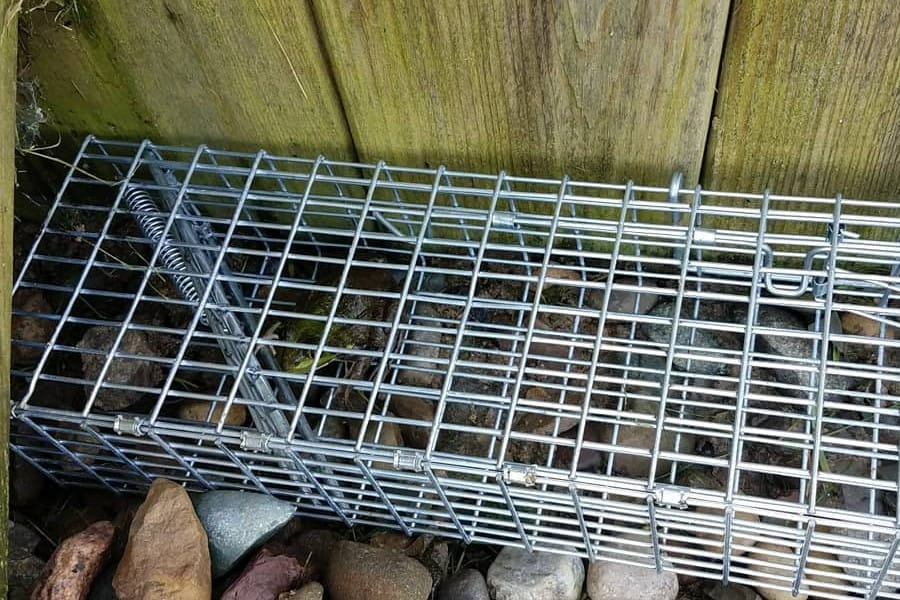
There are also many transparent two-door models made of lightweight plastic on the market. They work on the same principle as a cage but are better for several reasons. Firstly, the chipmunk does not see the metal mesh since the design is almost completely transparent.
This increases the chance of capture. Secondly, you can put bait of any size inside such a box, and the rodent will not be able to drag it away because the walls do not have holes. The animal will need to go into the trap to eat.
If you want to catch a chipmunk without a trap, be aware that this is a dangerous and inefficient activity. These animals are very agile and hide if they see a human nearby. They are not aggressive, but a cornered chipmunk can bite you. All warm-blooded animals carry rabies, and small rodents are no exception.
2. Trap placement and bait selection to catch chipmunks
Although chipmunks, like rats, can eat garbage, they will prefer tastier food if you offer it to them. The best option is to use peanut butter: The rodent loves it and won’t be able to drag it out of the trap without visiting it.
You can also use the following options as a bait:
- Bird seeds;
- Pumpkin seeds;
- Sunflower seeds;
- Raisins;
- Fruits;
- Berries;
- Mushrooms;
- Nutmegs;
- Animal feed;
- Unpeeled peanuts.
It is desirable that the size of the bait is larger than the holes in the cage. Replace baits with fresh ones every few days.
Poison baits typically are not used to kill chipmunks. These rodents have an excellent sense of smell and will not eat them, preferring natural food without chemicals. Difficult infestations are also rare, so humane traps with baits that keep the animal alive are more common.
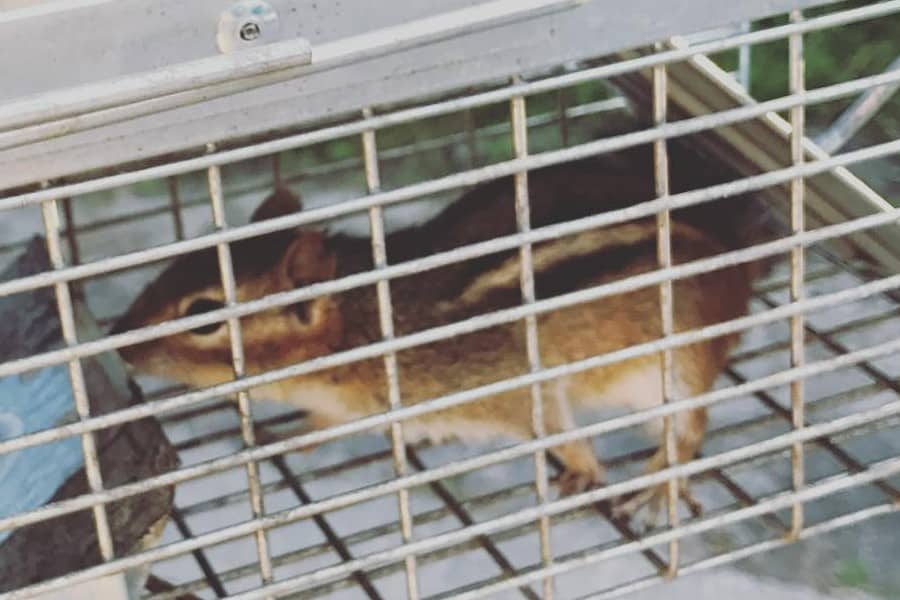
Basic rules for placing traps:
- Always use clean, thick gloves when handling traps for chipmunks and placing baits. The smell of a human can scare them away.
- Hide all the food in the house. You also need to hide animal food at night. Ensure that the chipmunks do not have access to garbage and bird seed. If there are many food sources in the house, the rodents will not be interested in the bait.
- Lay the bait next to the cage for several days so that the animals get used to it and later enter the trap without fear.
- Pay attention to the places where you most often notice the activity of chipmunks. Place the cages next to them. Striped rodents are attracted to covered spaces such as an attic, garage, or shed. They also typically move along fences and walls and under trees.
- Do not disturb the active trap, the options for catching small rodents are sensitive to movement and vibrations.
- Ensure that the trap will not interest your pets and small children. Traps are safe, but they can accidentally turn the structure over and also scare away rodents with their presence.
- You can also find burrows and make a bait trail out of them. Following this route will lead the chipmunk to the cage faster.
3. Check the trap more often
You are more likely to catch a chipmunk on sunny warm days as they are not as active in cool and rainy weather. Typically, these rodents come out to look for food at dawn. Check the trap at least twice a day, at noon and in the evening. It is impossible for the animal to remain in captivity for a long time; this will lead to starvation, dehydration, and stress.
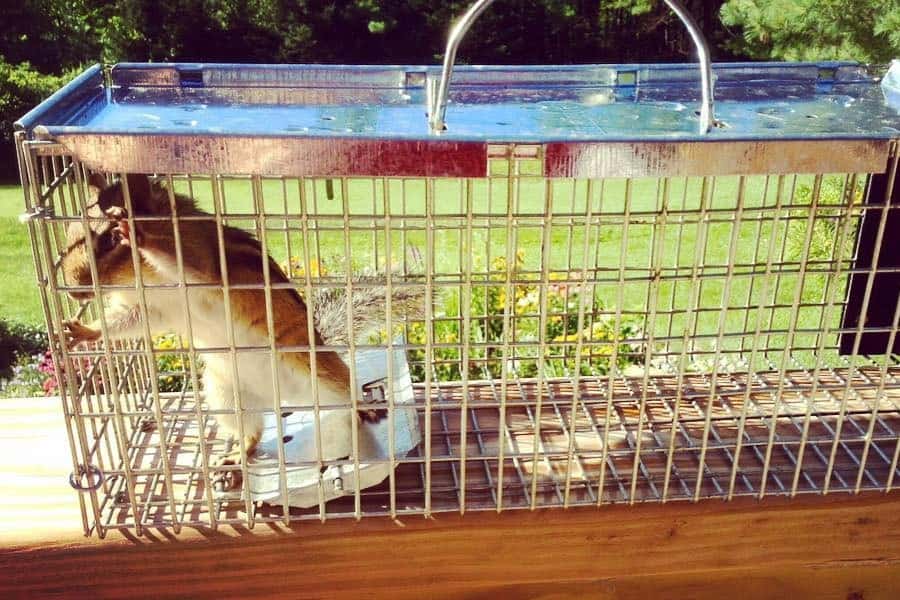
Tip: Use security and portable Wi-Fi cameras to check your trap. Some models also have motion sensors and will notify you when someone is near the cage.
4. What to do with captured chipmunks?
- Before setting traps, ensure to check your state’s laws about trapping chipmunks.
- After you find a hostage in the cage, put on thick working gloves to avoid infection and bites.
- Speak quietly so as not to startle the rodent.
- Place a thick towel or piece of cloth over the cage. The animal will feel safe. Also, place some dark material under the trap and secure it so that the rodent does not see the ground during transportation.
- If laws allow, take the chipmunk to a local park or forest. To ensure your guest does not return, the distance must be at least 5 miles. You can also contact local authorities. They will take the necessary actions.
FAQ on Chipmunks Trapping
Puffy-cheeked rodents are easy to catch when you know responses to key questions about trapping.
Can you catch chipmunks with mouse traps?
Snap and electric traps are suitable for chipmunks. However, if you live near a forest, rodents will come to your house from time to time, and you will have to exterminate them en masse. Correct placement of humane cages and a set of preventive measures will be the best solution.
How do you lure a chipmunk out of hiding?
These animals spend most of their time digging tunnels. They climb out to search for food. Offer them treats they can’t refuse. Near the hole, make a path of unpeeled peanuts that will lead to the cage.
What will attract chipmunks?
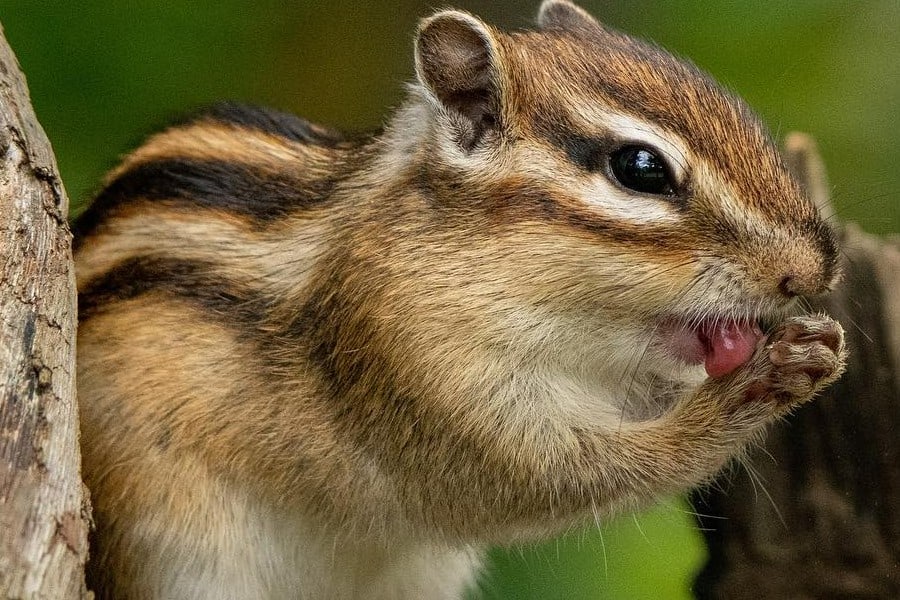
Chipmunks love natural foods like seeds, nuts, or fruits. In order to interest them in bait, it is necessary to limit access to all alternative food sources (human, dog, and bird food, garbage).
Release Chip and Dale Into the Woods
These cute critters can eat all your flower bulbs and bring fleas. Therefore, let them live in their natural habitat. Compliance with the rules of capture guarantees a positive result. After getting rid of them, consider preventing new guests from entering your home. You can put closed containers for garbage, close the cracks in the foundation with special materials that rodents cannot gnaw through.
Place bird feeders at least 15 feet from your home. I hope my tips will help you get rid of the invasion easily.
How effective do you think homemade traps are? Share your experience in the comments!

